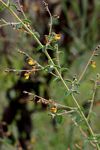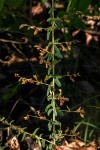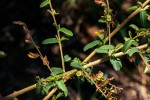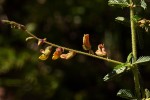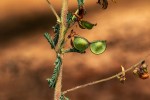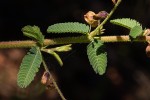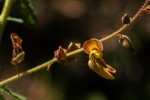| Home | > | List of families | > | Fabaceae subfamily Papilionoideae | > | Aeschynomene | > | mimosifolia |
Aeschynomene mimosifolia
Selected images: Click on each image to see a larger version and details of the record View all images (10)
Detailed records: Display species records QDS maps by: Google Maps Point records by Google Maps
Species details: Click on each item to see an explanation of that item (Note: opens a new window)
| Synonyms: | |
| Common names: | |
| Frequency: | |
| Status: | |
| Description: |
Perennial subshrub with slender prostrate or erect stems, growing from a woody rootstock. It may get up to 2 m tall but is usually much smaller. Stems pubescent with glandular tubercular-based hairs. Leaves often in clusters, short, up to 3 cm long, 8–34-foliolate; leaflets linear to oblong, 1–7 mm long, sometimes subfalcate, mostly hairless but often conspicuously glandular-ciliate; main vein more or less marginal; stipules linear- or ovate-lanceolate, 3–6 mm long, more or less persistent. Inflorescences axillary, often aggregated towards the apices of shoots to appear like leafy panicles; peduncle 5–15 mm long; rhachis 1–10 cm long; pedicels 2–5 mm long; bracts 2–3-fid, ovate, 2.5–3 mm long, ciliolate, soon falling; bracteoles ovate-lanceolate or lanceolate, 2-3 mm long. Calyx finely velvety, 2-lipped, one 2-lobed, the other 3-lobed and often ciliolate. Standard orange-yellow with purple-red veins, 7–8 mm long, emarginate; wings pale yellow, longer than the standard; keel petals greenish with reddish-purple nerves. Pods of 1–2 articles joined by a very narrow neck, hairless or finely velvety on the margins. |
| Type location: |
Kenya |
| Notes: | |
| Derivation of specific name: | mimosifolia: with leaves like a Mimosa, referring to the small leaves with small leaflets. |
| Habitat: | |
| Altitude range: (metres) | |
| Flowering time: | Aug - Dec |
| Worldwide distribution: | DRC, Kenya, Tanzania, Malawi, Mozambique, Zambia and Zimbabwe. |
| National distribution: | |
| Growth form(s): | |
| Endemic status: | |
| Red data list status: | |
| Insects associated with this species: | |
| Spot characters: | Display spot characters for this species |
| Literature: |
Da Silva, M.C., Izidine, S. & Amude, A.B. (2004). A preliminary checklist of the vascular plants of Mozambique. Southern African Botanical Diversity Network Report No. 30 Sabonet, Pretoria Page 65. Drummond, R.B. (1972). A list of Rhodesian Legumes. Kirkia 8(2) Page 216. Drummond, R.B. (1975). A list of trees, shrubs and woody climbers indigenous or naturalised in Rhodesia. Kirkia 10(1) Page 246. Mapaura, A. & Timberlake, J. (eds) (2004). A checklist of Zimbabwean vascular plants Southern African Botanical Diversity Network Report No. 33 Sabonet, Pretoria and Harare Page 46. Phiri, P.S.M. (2005). A Checklist of Zambian Vascular Plants Southern African Botanical Diversity Network Report No. 32 Page 56. Verdcourt, B. (2000). Papilionoideae Flora Zambesiaca 3(6) Pages 101 - 103. (Includes a picture). |
Other sources of information about Aeschynomene mimosifolia:
Our websites:
Flora of Malawi: Aeschynomene mimosifoliaFlora of Mozambique: Aeschynomene mimosifolia
Flora of Zambia: Aeschynomene mimosifolia
Flora of Zimbabwe: Aeschynomene mimosifolia
External websites:
African Plants: A Photo Guide (Senckenberg): Aeschynomene mimosifoliaAfrican Plant Database: Aeschynomene mimosifolia
BHL (Biodiversity Heritage Library): Aeschynomene mimosifolia
EOL (Encyclopedia of Life): Aeschynomene mimosifolia
GBIF (Global Biodiversity Information Facility): Aeschynomene mimosifolia
Google: Web - Images - Scholar
iNaturalist: Aeschynomene mimosifolia
IPNI (International Plant Names Index): Aeschynomene mimosifolia
JSTOR Plant Science: Aeschynomene mimosifolia
Mansfeld World Database of Agricultural and Horticultural Crops: Aeschynomene mimosifolia
Plants of the World Online: Aeschynomene mimosifolia
Tropicos: Aeschynomene mimosifolia
Wikipedia: Aeschynomene mimosifolia
| Home | > | List of families | > | Fabaceae subfamily Papilionoideae | > | Aeschynomene | > | mimosifolia |

